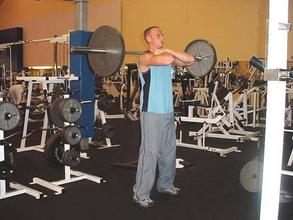The 6 WORST Exercises to NEVER Do
These 6 exercises are popular with most workout enthusiasts, but they could actually be HARMING your body!
by Dr. Kareem Samhouri - CSCS, HFS
Neuro Metabolic Fitness & Rehab Expert
Author of the popular program: Abs Strength Guide
Exercise is meant to help you, right?
Unfortunately, there are certain “exercises” in the gym that cause more harm than good. I’d like to take a strong look at the 6 most prevalent injury-causing exercises in most gyms. The worst part is that these exercises are pretty much useless when it comes to building strength or losing fat. There really isn’t much of a point in doing them, whatsoever, and yet they can destroy our results.
It’s time to put an end to the worst exercises on Earth. I’m here to help you understand how your body moves, why it responds to exercise the way it does, and how to minimize your risk while you maximize the effect from every exercise you do.
As a side note, I think it’s important to mention that the last thing I want is for you to feel discouraged; rather, it’s important that you feel inspired to know you have eliminated the negative from your exercise program. Now, you’ll be able to safely rely on the fact that “you’re doing it right” when you exercise. Plus, I think you’ll be shocked to realize how much you’ve learned about your body’s ideal positioning and muscle recruitment strategies with exercise.
The main reasons that an exercise would qualify in the following list is one or more of the following:
- Creates muscle imbalances
- Has zero functional benefit
- Winds up joint into unsafe position
If an exercise creates muscle imbalances, this can lead to joint deterioration all over your body and even blunt fat loss. You see, once your joints are out of position, your body has sub-sensory pain signals taking place all over the body. These pain signals tell your brain to shut down the muscles in the area in order to avoid “pulling on the injury” and causing more damage. The end result: no muscle contraction and weaker muscles.
We exercise to be stronger in our daily lives and live a longer/higher quality of life. If an exercise has no true benefit in either or both of these categories, then what’s the point?
Just because someone tries an exercise in a gym isn’t a reason to make this part of your routine. The gym is full of mostly amateurs, including several of the personal trainers at big name gyms. After all, that’s where many of us started out at one point or another...
“Winding up your joint” into an unsafe position involves increased pressure on the labrum or capsule of a joint while performing an exercise. Simultaneously, it’ll be likely that a muscle is being overstretched while being recruited to contract. This is a recipe for disaster. Instead, let’s find a position of rest for the joint and then exercise it. This will assist the natural delivery of nutrients to the joint and joint capsule.
Also important to mention, we should consider these two terms in understanding the benefits/consequences of an exercise:
- Active Insufficiency - this is when a muscle is over-shortened and you try to use it. An example is if you “make a muscle” with your biceps and then see how strong you are. The muscle is already short, so you’re not as strong as you are in the middle of the movement.
- Passive Insufficiency - this is when a muscle is over-lengthened and you try to use it. An example is if you tip your wrist back all the way and then try to curl your fingers. Because your wrist flexors are over-stretched, your muscles are having a hard time contracting. Again, you’d be much stronger if your wrist were in neutral, or halfway in between.
Lastly, I’d like to discuss the difference between open and closed chain exercises, and how this will affect the functional carryover in a particular exercise:
- Open-chained exercise: Fixed proximal segment, moving distal. Proximal means closer to your heart and distal means closer to your fingers and toes. So, in this case, it would be our hand moving towards our elbow (biceps curl), foot moving towards our buttocks (leg curl), etc.
- It’s important to note that open-chained exercises are very effective for sculpting muscles in the final stages of bodybuilding, or isolation training for rehabilitative purposes; although, they do create much more torsion into the joint and generally only exercise one muscle at a time. Due to these being isolation type movements, the metabolic effect of open-chain exercises is generally much lower than closed-chain movements.
- Closed-chain exercises: Fixed distal segment, moving proximal. This is just the opposite, so your foot would be fixed as your body moves closer to it (squat/deadlift), or your hands would be fixed as your body moves closer to them (push up, pull up.)
- Likewise, it’s noteworthy that closed-chain exercises are very effective at building balanced joints, spiking metabolism, and increasing functional gains in daily life while reducing or eliminating risk of injury. Closed-chain exercises have a higher metabolic effect because more muscle groups and joints are being used.
Ok, you’ve already got a great background for judging exercises and their quality, or lack thereof. Now, let’s dive in and take a look at the 7 worst exercises:
1) Leg Presses
These are awful. Here’s why: Creates muscle imbalances, zero functional benefit, winds up joint to unsafe position
Muscle Balance Perspective:
- Quads are generally stronger than hamstrings; this reinforces the problem.
When your quadriceps overpower your hamstrings in deep knee flexion, there is increased torsion placed into the meniscus, increasing the likelihood of knee injury.
- Quads and glutes should be used as a pair. In this case, they are not being used effectively.
When your glutes do not fire while using your quads with a great level of force, there is increased risk of low back injury.
An imbalance between your quadriceps and hamstrings can quickly result in a number of knee issues, including patellofemoral (kneecap) and meniscus damage. Even worse, when your quads overpower your hamstrings, it’s not uncommon to develop restrictions in these muscles as your body attempts to even things out. These restrictions lead to increased pull on the top of your pelvis, tipping it forward, and placing pressure in your low spine.
Read more...
















